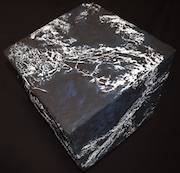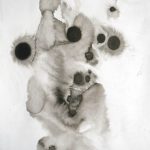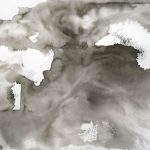Forum Magazine, Macedonia
Interview with Robert Rich and Marjan Kostadinovsky
April 2004
Q: From the interviews with your fellow musicians (Roach and Obmana) one can see that they are inspired by deserts (Roach) and Obmana is inspired by photographies. One can notice that in your case journalists are most interested in your all-night sleeping concerts that you did in the past. As a psychologist and a musician why do you think human subconscious is so attractive to people?
A: It interests people because it ticks inside of us, the ghost in the machine. It’s a deeper mystery than the depths of the oceans or outer space. The more we look for the self, the more elusive it becomes, until we see that the only way to find it is to make it disappear. Thus begins a lifetime search for silencing the inner chatter.
It’s probably too simple to say that any one of us musicians has only this-or-that inspiration. I know we are all fundamentally inspired by the sense of being alive, and beauty of existence, and we use various stimuli to remind us of that intense feeling of now. For me, indeed, I am forever amazed by the ability within the human mind to become more aware of these fleeting moments, and I seek to always remind myself of this potential. However, the world around me, and the works of certain other artists, also create such reminders, and I feel inspired by all sorts of things.
Q: How do you look back at the experience with these sleep concerts?
A: They leave a mixture of impressions. For me, of course, I was exhausted at the end, so my memories are somewhat foggy. The logistics were always difficult. But on the other hand, the experiences of the listeners seems to have been very intense for some, very beautiful for others, and for some perhaps a bit puzzling or just strange. I think the Sleep Concert concept never quite found the perfect environment. I constantly struggled for a setting where I could create the kind of intensity that I desired from the experience. I came close a few times, perhaps.
Q: Do you go reflect on your older work very much?
A: Sometimes, to remember certain things I did that seemed to work well. Usually I try to move forward and not repeat myself. When I do hear my older albums, I am usually happy that they still sound good. I am especially happy that albums like Trances/Drones and Numena still sound fresh after two decades.
Q: Tell me about the performing with adventuresome musicians such as Vidna Obmana and Steve Roach. How does their approach to making music affect your playing style?
A: Actually Dirk Serries (Vidna) and I have never performed together, although we have played at the same festivals, and we have always liked each other. Likewise, Steve and I remain friends, although our approach to making music is very different. I think this difference helped to make our collaborations quite interesting. We haven’t worked together for over ten years, so I can’t accurately comment on his approach to making music. I know I tend to work much more slowly than Steve, and I am attracted to different sorts of sonic textures. Still, he is a true master of his vocabulary.
Q: In relation to musicians would you care to shine any light on any other musicians or musical styles that have influenced you?
A: Usually I am influenced by styles different from my own. I listen to a lot of jazz (Coltrane, Sun Ra, Keith Jarrett, Bill Evans, etc.), I like Indian classical music, Minimalism (Terry Riley especially) and a wide range of odd pop music from Nick Drake and Neil Finn to Bjork and Massive Attack. Everything influences me, but there’s always a strange hermetic place inside where my own music comes from. The music just tends to happen on its own, so it’s hard to say what influences it sometimes.
Q: Are you personally more passionate about any specific musical style?
A: No, I like anything with intensity and humanity, heart and mind, pure expression and lasting depth.
Q: You are probably the first artist that truly explores the possibilities of the relatively new medium-DVD. The music on it spans for seven hours. What are the challenges when working with this format? Do you have any future plans for further work in this field?
A: Many people like DVD because they can put visuals with their music, but this does not interest me so much. I waited for years to have a medium to play very long durations, so of course I was very happy to release Somnium when DVD became available. I think the surround format also offers many interesting possibilities with electronic and ambient music, and I would like to develop something in that direction, but I need to make some changes in my recording sudio first, to accommodate the technology. We’ll see what happens.
Q: In relation to technology do you get frustrated with the technological side of making an album? How much does modern technology interfere with the creative process?
A: Every tool has its strengths and weaknesses. Recording technology keeps getting better and cheaper, and most of the process is getting easier. Personally I tend to use a lot of older technology, I guess it makes me work harder; but sometimes the new tools make it harder to do something that was easy before. For example, I prefer to work in Just Intonation, an alternate tuning system based on ratios between frequencies. Most of the new soft-synths and computer-based samplers do not support microtuning, so I can’t use them. Also, I suppose I am a bit old-school: I like to work with real knobs and physical instruments. I find that I can perform my ideas more intuitively when the interface is more direct and tactile.
Many of the modern music-making tools aim their features at techno and dance music. I find that these tools tend to suggest directions that pull people towards certain styles, and reduce their natural tendency towards originality. They make it easy to import loops and rhythms that conform to rigid rhythmic boundaries, but they make it more difficult to work in complex polyrhythms or in more fluid ways. I prefer to stay with tools that work in a more stylistically neutral manner, more like an old recording studio. But I’m a bit strange this way, I sometimes like to work more slowly. I don’t know why, but it helps me to sound more like me when I have to struggle a bit.
Q: Many musicians limit their musical growth or contributions by avoiding risks. What advice would you give to musicians to help them get around this problem?
A: Ignore stylistic boundaries! As you know, I tend to experiment a lot, and I probably alienate some of my listeners each time. So, hopefully my audience starts to expect a bit of a surprise with each album. The funny thing is that I have made fans from my more “difficult” albums (like Bestiary or Stalker), while those same albums may have disappointed other fans who liked my more melodic work. I don’t release all my experiments. Sometimes I just try something to learn how it sounds, then I throw it away. These “failed” experiments still teach me new techniques and vocabularies, which hopefully expand my horizons for future projects.
Q: Today we are literally flooded with electronic music. What is it that some of the newer music is lacking?
A: I would avoid lumping everything together. There is a lot of very good new electronic music coming out. The less-good electronic music seems to suffer mostly from unoriginal mindless repetition, boring recycling of appropriated loops, heartlessness, etc. But you could say similar things about any bad music. I would rather focus on the good stuff. Perhaps it’s just getting harder to discover within the noisefloor of information.
Q: What are some of the misconceptions about ambient music? What are some of the sonic challenges when working in this area?
A: The name “ambient” itself tends to create the impression that the music is intended for background listening, to be ignored in the sense that Eno originally intended. However, many of us whom people consider to be ambient artists make music that we want to be psychoactive, to engulf the listener and create a full sonic surround, like an aural movie. Our intention is not to create calm, passive background music, but to engage the listener in new ways. For this reason I prefer Pauline Oliveros’ term “deep listening music.”
Hopefully I won’t alienate people with this next comment – it’s easy to misunderstand outside of the context of your previous question: Another misconception is that ambient music is easy, quick, and ill-considered, an idea that spread after the flood of tossed-off releases by Pete Namlook, Bill Laswell and others. I wish people would edit themselves better. Now we have so many bedroom synthesists releasing CDRs every month, whenever they discover a new preset on their synthesizer. I think it’s wonderful that technology has empowered people to record and release their own music (and I have benefited from this myself of course), but I wish people would realize that they don’t have to release every bleep they ever made. Just because they *can* release it doesn’t mean they *should* release it. “Ambient” has become a bit of a trash-can category for lazy home-recording, and that has watered down the impact and potential of the few more carefully considered releases to reach an audience.
To answer your second question about sonic challenges: for me, I am always striving for a deep and lush soundstage, but I also search for some new or interesting way to assemble musical ideas within that lush environment. The challenges for me are more compositional than sonic. I want to find new ways to express the music I hear in my head.
Q: I am curious how you see your influence on younger electronic artists?
A: The younger artists who contact me seem most influenced by my early slow work, like Trances/Drones, or by my more intense releases like Stalker or Bestiary. I sometimes wonder if DJs like this work because they can mix beats on top of it without interference. I think many of the people who grew up during techno think that all music must have beats, and electronic music is synonymous with dance music. Those who discover our territory of slow introspective music start to appreciate the details within sounds; they learn to pay attention to the texture, not only to rhythm.
Q: Your music is usually released on independent labels like Projekt. Being independent obviously doesn’t pay as well as being with a major label, nor does it give you the same visibility, but does it give you more satisfaction as an artist?
A: Indeed it gives me more satisfaction, more freedom, and better pay. The kind of music that I like to make would never sell enough to attract the interest of larger labels. Major labels waste so much money in marketing and overhead that they would not offset their costs with music like this, and artists like me would see our albums cut-out immediately. We saw this happen in the 80’s with people like Michael Shrieve and Giles Reaves on MCA, or more recently with the excellent Sony Classical release of Richard Horowitz and Susan Deihim, which completely vanished. The label couldn’t figure out how to sell it. Currently, I prefer to release titles on my own label, where I have complete control, I can experiment with new directions, and I can actually earn enough money to survive through direct sales off my website.
Q: What other interests do you have outside of your music that soothes your soul?
A: I’m always fascinated by the world of smell and taste, and I enjoy things that come out of the earth. I have been exploring winemaking for the last few years, and I sometimes make odd extractions from herbs that we grow in the garden. I enjoy writing, and wrote food articles for a local newspaper for two years. Otherwise, when I am not in the studio I like to be outside walking, or talking with friends around a slow meal at home.
Q: In relation to psychology and human subconscious i wonder whether you have read Solaris by Stanislav Lem upon which 2 films were based (i believe you did). I love the ideas around that book as it opposes to the usual ways SF books are written. It was interesting that that the Ocean was interested in seeing what’s in the subconscious and not the actual outlook. Maybe the subconcious was the face it was looking for. Sometimes it made them face with what was in there. What’s your take on this?
A: Actually, Lem is one of my favorite science fiction writers (others include JG Ballard, Ursula Le Guin) and I agree that Solaris is one of his best books. The idea that interests me most in that book (and many other Lem stories) involves what happens when human intellectual hubris becomes humbled by the confrontation with a completely “other” mind, something so much larger and so different from ourselves that we eventually realize that we will never be able to understand. I am fascinated with this idea of the unknowable otherness, something which humbles us. Many of my “darker” works like Below Zero and Stalker focus on this idea of the unknowable – I don’t actually see that work as dark at all, just mysterious.
Q: I was delighted to read that you wrote food articles for local newspapers. Probably you didn’t know but John Cage loved to collect (and eat ) mushrooms. I also checked the links from your website which indicate that you are interested in geometry. You even have an album called Geometry. What do you find about geometry that is attractive to you?
A: Indeed I am well aware that Cage was a mycophile. In fact he wrote one of the classic texts on East Coast North American fungi, back in the fifties, and he started the New England Mycological Society. Personally, I fell in love with mushrooms during a two year period when I lived on the coast near Big Sur (a very beautiful part of California) and found edible mushrooms growing in my yard. As for geometry, like other branches of mathematics it shows us aspects of the hidden beauty behind the structure of things, like a lattice of meaning that permeates reality. Because geometry has concrete visual qualities, it is easier for me to grasp both mathematically and metaphorically than some other more abstract forms of mathematics.
Q: The artwork on your cds is fantastic especially Numena/ Geometry and Trances and Drones. Do you think cover art adds anything to the music when it’s released?
A: I like a CD to become a complete physical object, a work of art. The cover is more than just packaging for me, it involves collaboration with visual artists whom I admire, and helps add layers of meaning the music. People who only download music to fill their computer hard disks miss out on this physical side of the release.
Q: Your web site has links to a visual artist Brad Cole. I believe he did the artwork for some of your releases. Also the new album “Calling Down the Sky” has an interesting photography by John Bergin that is similar to the works of Stu Jenks. (Stu Jenks did the cover art for some of Steve Roach’s albums (Atmospheric Conditions). His specialities are circles and he ads something spiritual i.e. his works are like a ritual captured). What is it that you find so attractive in the work of these people?
A: I have always had a close tie to the visual arts, and I occasionally pursue some visual projects of my own that include sculpture, photography and painting. I grew up with a fondness for the work of Surrealists like Miro, Tanguy, and Ernst. (My album Bestiary pays homage to that.) When I met Brad Cole, we saw in each other a kindred spirit, a common goal to express the ineffable in art. He has been trying to make images that contain a special energy, a mythical force, just as I have been trying to do with music. I am a huge fan of his work. Likewise, John Bergin has been immensely helpful, as a collaborator who has helped me realize several difficult visual ideas for cover art. He always manages to push the artwork into surprising directions. He creates images that contain special friction, something perfectly asymmetrical and “wrong” that makes the image move. I feel very lucky to have him making my covers. As you say, the spiral in the foreground of “Calling Down the Sky” seems to add a human dimension to the images of violent weather, integrating the idea of a shamanic exchange between music and the elements.
Q: Can you describe the philosophical intersection where art and music meet for you?
A: All forms of human expression can be directed towards the miraculous, towards the mythic dimension. For me, the *purpose* of making art matters more than the medium that one chooses. I make music, I suppose, because I’m better at music than at other artforms. If I find ways to impart the same striving into other creations, I do, or I become attracted to others’ work who also strive for this energy. I don’t care whether it’s writing, gardening, dancing, cooking, filmaking, or raising children. All activities can express the miraculous, if we choose to focus on that energy.
Q: Many perceive a deep, spiritual element in your work. Is there a particular path you follow when creating your music?
A: I don’t intend my music to express any specific philosophy, and I don’t follow a specific spiritual path; but I admit that I seek something higher when I create. I would not presume to say that I succeed in reflecting that search in the end result, although I try. The older I get, the less embarrassed I feel about using words like “beauty” and “truth”, or even “God” although my own conception of the sacred doesn’t fit cleanly into religion. If my music makes someone feel a droplet of personal truth, perhaps inspires a dream or an act of kindness, then I consider it successful.






You must be logged in to post a comment.